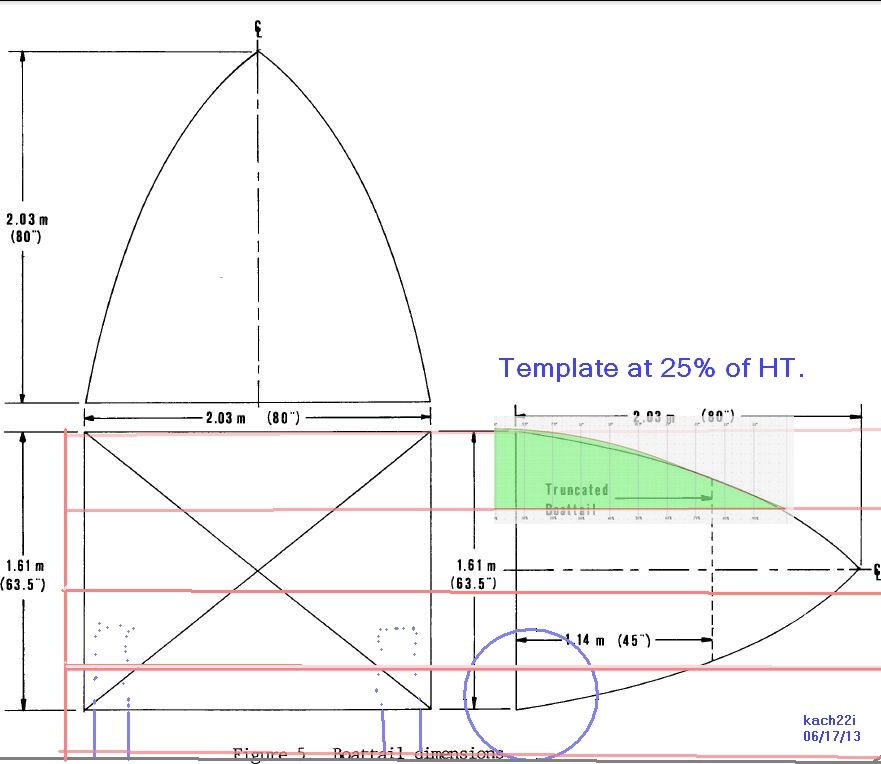Quote:
Originally Posted by kach22i

Nice post.
If we take a car of approximately 4.5 feet in height, the boat-tail would be 3 Ft 4-1/2" long, right?
The 75% of body height, that's a scaling factor, right?
In effect, we can scale down the template 70-75% (range listed) and get 97% (31/32x100) of it's benefits, right?
Why don't we just scale down the template then?
Is there a chart showing the losses when scaling down?
Say for instance:
X.100/100% (1:1)
X.75/97%
X.50/39%? (just a guess)
It's that last ratio I'm interested in most. (see edited comments far below)
If I had at least three reference points I could start to chart this scaling relationship of L to H and percent of boattail affect.
EDIT-1:
Automobile 2 - Odds And Ends Photos by kach22i | Photobucket

 EDIT COMMENTS:
EDIT COMMENTS:
Scaling down the template for "boattailing purposes" by a factor of 75% to get it to 1/4th of it's original size results in getting 31 mpg in lieu of 32 mpg on a Dryden/NASA style van, right? |
If we go back to the fundamental premises which form the methodology of the 'Template' construction we run into scaling snags:
*We're going after pressure drag which is a symptom of flow separation.
*The contour of the 'Template' is based on the mirror-image,ground reflection of the Cd 0.04,2.5:1 fineness ratio streamline body of revolution which is separation-free.
*This body is separation-free only because of its exact contour,based on its distance above the ground plane.
*Any 'steepening' of the contour (which would come about from scaling) triggers flow separation immediately,due to the adverse pressure gradient created by the rapid pressure rise generated by the steeper slope.
*Once separated,the flow will never re-attach and all the kinetic energy which might have energized the wake is lost to viscous attrition.
-------------------------------------------------------------------------
If you're going to do a 'composite'(combination form) body,with body,wheel area,and greenhouse agglomerated together you'll need to rely on Hoerner's work.It is a 'BIBLE' of aerodynamics from which Hucho leans heavily.
There are 'scaling' relationships there,and it runs in the opposite direction from what you might think.
-------------------------------------------------------------------------
For 'typical' passenger cars and pickup trucks the 'Template' should be used only as illustrated.You can go 'longer' as THIS will not introduce flow separation,but bear in mind that the structure becomes weaker as you move away from a spherical/ovoid form,requiring internal reinforcement to counteract aeroelastic effects.
-------------------------------------------------------------------------
For buses,motor homes,tractor-trailers you might consider wing section/struts.
If you intend to do a limited-length tail,with no intention of future streamlining,then consider the GM Optimum boat tail.It will have hard angles of :
19-degrees @ top
10-degrees @ sides
10-degrees @ bottom
panel intersections chamferred into a radius which grows with length.
-------------------------------------------------------------------------
Fachsenfelds 1936 Onmibus passenger bus with inflated boat tail followed the 'Template' fairly close and came in at around Cd 0.257 if memory serves me.
It's the best I've ever seen.